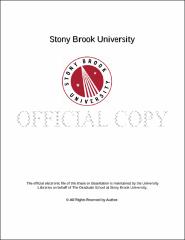| dc.identifier.uri | http://hdl.handle.net/11401/77145 | |
| dc.description.sponsorship | This work is sponsored by the Stony Brook University Graduate School in compliance with the requirements for completion of degree. | en_US |
| dc.format | Monograph | |
| dc.format.medium | Electronic Resource | en_US |
| dc.language.iso | en_US | |
| dc.publisher | The Graduate School, Stony Brook University: Stony Brook, NY. | |
| dc.type | Dissertation | |
| dcterms.abstract | Understanding the impact of post-translational modifications in the context of the complexity of the human proteome is extremely challenging. Part of the challenge lies in cataloging the proteins that are modified with any given post-translational modification, and how this list changes in response to changes in cellular/tissue physiology. The O-GlcNAc modification is one such modification that involves an addition of a single N-acetylglucosamine moiety onto serines and threonines of eukaryotic proteins. This dynamic modification is mediated via two enzymes: O-GlcNAc transferase (OGT) for installing the sugar and O-GlcNAcase (OGA) for cleaving the sugar off modified proteins. O-GlcNAcylation occurs mainly in nuclear and cytosolic proteins ranging from structural proteins and enzymes to transcription factors and tumor suppressors. The dynamic nature of the modification, which can be compared to phosphorylation, has emerged as an important player in signaling, regulation of metabolism, nutrient response and disease onset. Despite being implicated as a key regulator of cellular physiology, O-GlcNAc remains ill-defined due to a lack of effective analytical tools. In this context, the chemical reporter strategy, which installs a chemical handle that can be later modified and monitored, provides a potential solution. Here we detail efforts towards installing chemical reporter mimics of O-GlcNAc and using them to profile the repertoire of proteins modified with this post-translational modification. In particular, we chose to scrutinize the involvement of O-GlcNAc in the activation of T lymphocytes, which was prompted by the discovery that OGT is essential for T and B lymphocyte activation. | |
| dcterms.available | 2017-09-20T16:52:04Z | |
| dcterms.contributor | Carrico, Isaac S | en_US |
| dcterms.contributor | Drueckhammer, Dale | en_US |
| dcterms.contributor | Koch, Stephen | en_US |
| dcterms.contributor | Koller, Antonius. | en_US |
| dcterms.creator | Rajaram, Lakshmi | |
| dcterms.dateAccepted | 2017-09-20T16:52:04Z | |
| dcterms.dateSubmitted | 2017-09-20T16:52:04Z | |
| dcterms.description | Department of Chemistry. | en_US |
| dcterms.extent | 100 pg. | en_US |
| dcterms.format | Application/PDF | en_US |
| dcterms.format | Monograph | |
| dcterms.identifier | http://hdl.handle.net/11401/77145 | |
| dcterms.issued | 2015-08-01 | |
| dcterms.language | en_US | |
| dcterms.provenance | Made available in DSpace on 2017-09-20T16:52:04Z (GMT). No. of bitstreams: 1
Rajaram_grad.sunysb_0771E_11517.pdf: 15028387 bytes, checksum: 84b8a4e0019fb5aa96ec20328144017d (MD5)
Previous issue date: 2013 | en |
| dcterms.publisher | The Graduate School, Stony Brook University: Stony Brook, NY. | |
| dcterms.subject | bioorthogonal chemistry, chemical biology, O-GlcNAc, T-cell activation | |
| dcterms.subject | Chemistry | |
| dcterms.title | Probing O-GlcNAc Modifications Via Metabolic Labeling Using Unnatural Sugars | |
| dcterms.type | Dissertation | |

